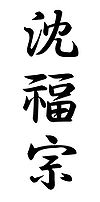|
Michael Shen Fu-Tsung
Michael Alphonsus Shen Fu-Tsung, SJ, also known as Michel Sin, Michel Chin-fo-tsoung, Shen Fo-tsung, or Shen Fuzong[1] (Chinese: 沈福宗; pinyin: Shěn Fúzōng; Wade–Giles: Shen Fu-tsung, c. 1658 – 1691),[2][3] was a Chinese mandarin and Jesuit from Nanjing. He was a convert to Catholicism who was brought to Europe by the Flemish Jesuit priest Philippe Couplet, Procurator of the China Jesuit Missions in Rome. They left Macau in 1681 and visited together Flanders, Italy, France, and England. He later became a Jesuit in Portugal and died near Mozambique while returning home. Visit to EuropeFlanders and RomeMichael Shen Fu-Tsung arrived with Philippe Couplet by boat from Portuguese Macau in October 1682. They visited the city where Couplet was born, Mechelen. They then left for Rome, where Couplet tried to obtain a Papal authorization to celebrate mass in Chinese.[4] France Shen was presented to King Louis XIV on September 15, 1684, and he demonstrated how to use chopsticks and how to write Chinese characters.[5] He is described as participating in a royal dinner with Couplet, wearing green silk with deep blue brocade, decorated with Chinese dragons.[4] They also visited the Maison royale de Saint-Louis, where they set up a display of Chinese silk portraits.[4] England and later lifeAfter his visit in France, Shen Fu-Tsung also went to Oxford where he met with Thomas Hyde in 1685,[6] and he taught him some Chinese.[7] Shen Fu-Tsung apparently communicated in Latin.[8] Shen Fu-Tsung also met with King James II.[9] It is the first recorded instance of a Chinese man visiting Britain.[10] The king was so delighted by this visit that he had his portrait made, and had it hung in his bedroom.[10] Shen Fu-Tsung was able to catalogue the Chinese books that were present in the Bodleian Library, and to describe their content, something which nobody had been able to do until then.[10] He also showed the librarian the correct way to hold a Chinese book, starting with which way was up.[10] Shen Fu-Tsung left England in 1688 and went to Lisbon, where he entered the Society of Jesus. He died in September 1691 of a shipboard fever as he was returning to China, somewhere near Portuguese Mozambique.[1] See also
Notes
References
|
||||||||||||||||||||||||||||
